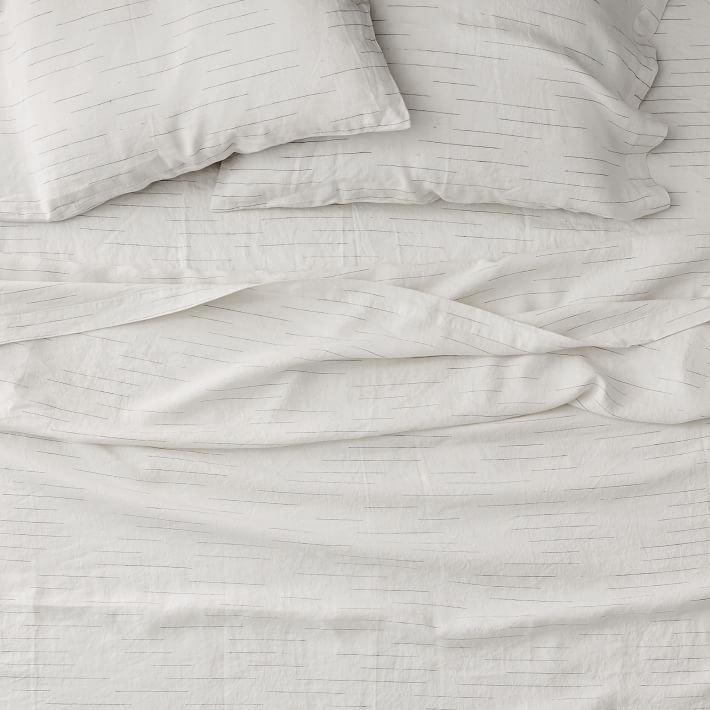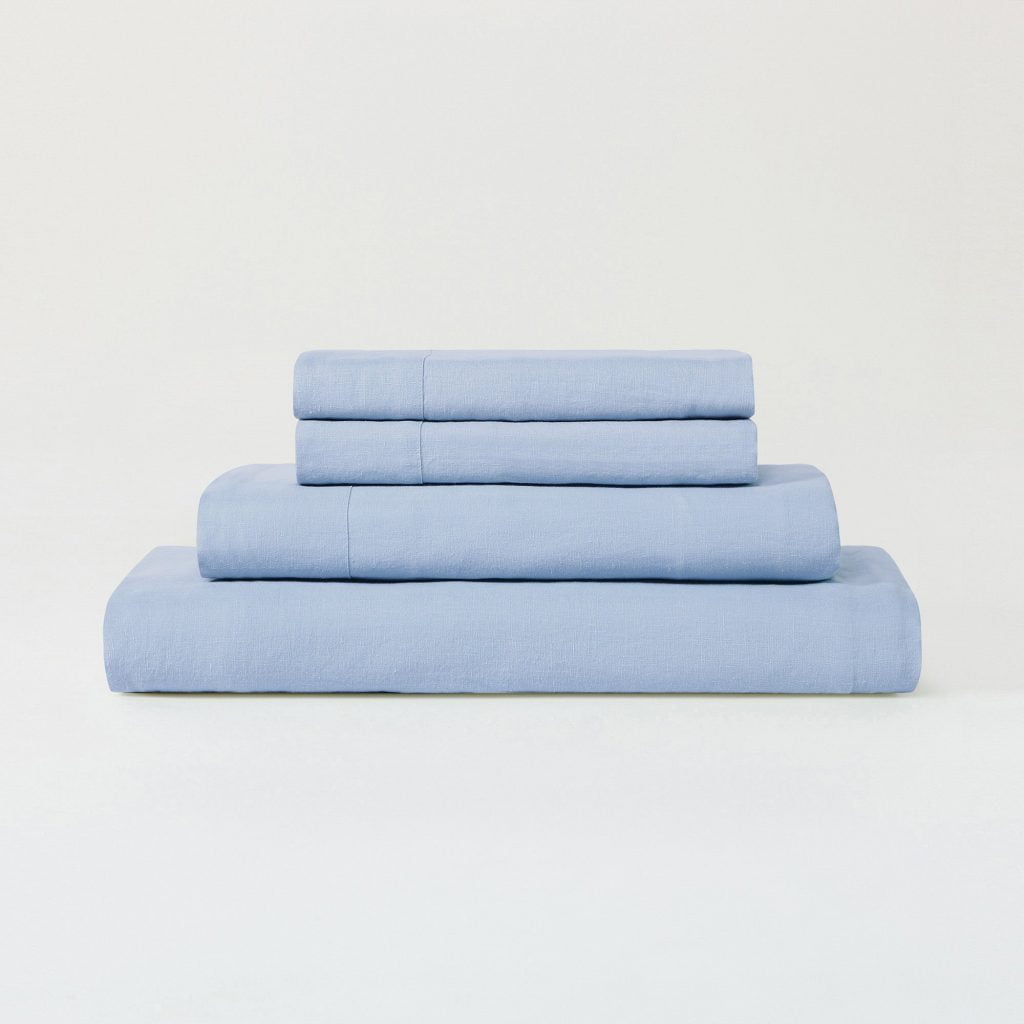A Linen Sheets Review – Please note that this is an unpaid review of products that were purchased by me.
By Ellen Rubin
Change Your Sheets…Improve Your Sleep
I have slept on cotton percale sheets my whole life and never really thought about sleeping on anything different until I researched and wrote The Most Sustainable Sheets: Guide for a Good Night’s Sleep (unsustainablemagazine.com). Just researching the article changed my thinking.
First, I think it’s only fair to tell you that for a number of reasons I’m a terrible sleeper. I usually wake up more than once during the night, it’s not unusual for me to only be able to sleep 4-5 hours, although my body would really like 7-8 hours, I’m sleeping on a mediocre mattress and box spring because that was what I was able to afford, and our house is usually too hot (summer) or too cold (winter).
With all that being said, I decided that I might be able to improve some of those issues with a change in sheets. After going through the buying guide, I came to the conclusion that either hemp or linen would be the best choices because of their thermoregulating properties. It was narrowed down even further when I realized that at this time, hemp is very limited. So, linen it was.
Finding My Sheets
If you look through the buying guide, you’ll notice that linen is expensive. I’m on a tight budget so for me to splurge on something like linen sheets is really a luxury and price had to be a determining factor. I started by looking for sales. I’m flexible on color so that wasn’t a limiting factor. I kept on eye on all the companies in the guide, as well as looking on Amazon.
I wasn’t too concerned about looking for organic or sustainable, one, because I’d already done that research, and most importantly, linen is almost generally sustainably grown and processes – it’s just the nature of the fabric.

First Linen Sheets Review: West Elm
I got lucky when a color of West Elm sheets went on sale. It was even in a color/pattern that went with the comforters/blankets I have. Just a note, it seems that West Elm rotates what colors will be on sale at different times. If you are interested in their sheets, and are looking for a sale, check the site periodically.
The sheets came in a reasonable amount of time, were packaged in a cardboard box (although I thought the box was about 30% larger than it needed to be so that was a bit wasteful), and then in a plastic bag. They arrived in good shape.
Washing the sheets before the first use is always interesting to me. Just how much lint will be created. With these sheets it was a lot! I washed them separately, and have continued to do so because even after a 4th washing there is still a lot of lint. Am I the only one who wonders when this will stop and is the weave on my sheets going to get so loose with all this loss that they will wear out? I know that linen is a really sturdy fabric that is supposed to get stronger with each wash. This is a question that only time will solve.
My First Night’s Sleep on Linen
Now to the important part…linen sheets were a revelation! They actually make a difference! The first time I slid into bed my immediate reaction was that I was cuddled by the sheets. Linen is much heavier than cotton sheets so the top sheet sluffs or hugs you. I molded to my body and even though I didn’t have a lot of heavy blankets on at the time, it felt weightier without weighing me down. I hope that makes sense to you. I felt comforting and secure.
The next thing I noticed when I woke up the next morning, is that I actually slept better. I’m usually a quiet sleeper, but I think I moved around even less and slept 6 hours straight – almost unheard of for me.
My first try was during warmer weather – not summer hot, but early fall warm. I didn’t wake up hot like I do many nights so I was happy about the temperature regulation, but how they held up in extreme weather would have to wait. Over the course of the next few nights I noticed that I didn’t have to add or remove blankets during the night like I often have to do. Another plus.
Linen sheets are not crisp. This doesn’t bother me, but expect some wrinkles. You also have larger threads and a looser weave than cotton sheets so they might feel more coarse.
I have to talk about the pillow case. This is probably the only part of linen bedding I didn’t like. First, West Elm pillow cases don’t have an envelope closure so the case always twisted. This is a matter of personal preference; I have a foam pillow that isn’t super fluffly, but molded, so the twisting was a huge problem.
Also, after a week, I noticed that there was a lot of hair on my pillowcase. Either my hair was falling out, or it was just sticking to the case because the linen is not as smooth as the percale I’m used to. I switched back to my old envelope pillow case and didn’t see any more hair, either on the case or around it. I wonder if the linen was just grippier than the percale and grabbed onto hair that might have fallen out during the day. Regardless, I’ve stuck to the old pillowcases because they are more comfortable – at least for now.
Linen vs. Flannel – a Battle for Warmth
When it was time to wash my sheets the weather had taken a turn to frigid, so I decided to put on a set of flannel cotton sheets I had. What surprised me was that the linen was actually warmer than the flannel.
When you first slide in on a cold night, linen, like every other sheet that isn’t heated, is cool. Usually, it takes a while for the sheets to warm up, and once you move from the one spot, you hit cold sheet. The linen isn’t hot or cold (like cotton), but cool at first touch – so at least I wasn’t starting from scratch in the warming process. What I noticed was that the linen warmed faster, and the warmth spread a bit so I wasn’t going from hot to cold if I moved. I used fewer blanket layers and stayed more comfortable than I did with even flannel sheets.
Since I didn’t have more than one set of linen sheets I couldn’t compare brands; I didn’t know if my miniscule issues were with linen in general, or this brand in particular. For instance, the pillowcase twisting, the sheets got a bit fuzzy after a few nights, and they were also a bit too big for my bed.
I’ll admit that my mattress isn’t deep, super padded, or luxurious, and manufacturers have to make their sheets to fit the deeper mattresses that are popular. I imagine that is especially important for luxury sheets – which is where I put linen on price point alone. However, that means that if you have my mattress, you have a lot of extra fitted sheet fabric that just gets bunchy.
The top sheet was actually large enough to tuck in on all sides and have enough for a nice fold-over at the pillow end. I often go up a size in top sheet when I buy sheets separately because I like to have enough fabric on the sides. This top sheet was more than sufficient.
The sheets washed well, and dried fairly quickly with the use of wool dryer balls. (Side note, if you don’t know about wool dryer balls, you should look into them. They help dry clothing more quickly with fewer wrinkles.) There is still a lot, but not as much lint, at the 4th drying.
Sijo: Linen for Life

I really loved my linen sheets for their temperature control and heavy weight (without undue heat retention in hot weather). Now I was curious how my set stacked up against another brand.
So, after a search for a set I could afford, I found Sijo. This isn’t a company I found when I put together my Buying Guide but they certainly deserve to be there. I believe they are fairly new. They sell French linen and eucalyptus bedding, as well as a thermoregulating blend of Tencel Lyocell, nylon, and recycled polyester in their CLIMA line.
I purchased a set of linen sheets. The very first thing I noticed (again) is how heavy linen sheets are. This contributes to their snuggly feel. I also appreciate the linen bag that the sheet set came in. Many sheet sets come in these self-fabric bags and even when I don’t reuse the bag immediately, I just like that touch.
These sheets fit better. They still have a deep pocket so if I had a deeper mattress the bottom sheet would still fit, but the way the elastic and pockets are made just hug my mattress better so I don’t have as much bunching in the middle of my bed. The top sheet is the same size so it’s large enough to tuck in on all sides.
There was less fuzz (although still enough that you would want to wash and dry separately) in the first laundry cycle and the sheets seem to be a bit smoother. I’m still sticking with my cotton pillow cases, but will probably give the Sijo linen a try and see if they also attract loose hair.

I chose sky blue which turned out to be a really nice color – it has a hint of periwinkle for a warm feel, yet is a true medium blue. The weave is tighter than the West Elm set and seems to wrinkle a bit less.
Both sets of linen sheets have labels for the top and sides on the fully elasticized bottom sheet. My Sijo sheets are just as thermoregulating and allow me to (usually) sleep better than my cotton percale or flannel sheets have.
I also want to mention that Sijo is very customer service oriented. There was a personalized thank you card and they follow up with a request for a review. You aren’t ignored, but you don’t get bombarded with daily “buy more” emails.
Final Thoughts on these Linen Sheets Reviews
After sleeping on cotton sheets (I won’t even mention any cotton/poly sheets I might have had in the past and an unfortunate purchase of microfiber) I can say that linen was a revelation. They aren’t as smooth as cotton, and if you are used to sateen sheets these would probably feel too coarse, but I’m now sleeping more soundly on a sustainable fiber that was made with few chemicals.
I truly didn’t think that changing sheets would matter, but I was immediately amazed at the difference in my sleep and comfort. While I would also consider trying hemp, I’m a linen convert. They are worth the investment, assuming they hold up to years of use. By buying linen I’m helping myself, and the planet.